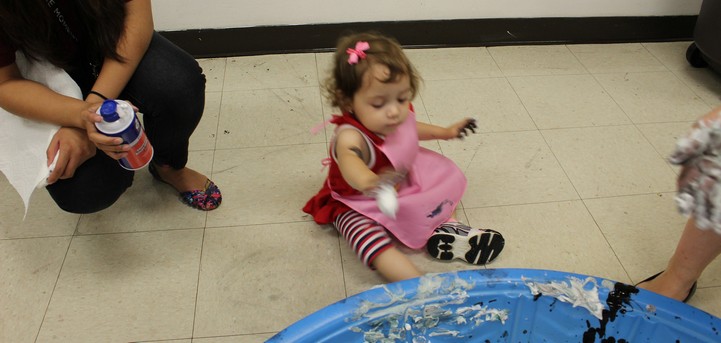
During the first three years, young children develop their artistic skills by having fun experimenting and learning all the wonderful things they can do. Child care providers need to understand how children’s art abilities develop in order to plan effective art experiences for the child care program.
Art for 0 and 1 Year Olds
When babies engage in creative art, it is a whole body experience. They often are as interested in grasping, chewing, pounding and squishing as they are in trying to actually create something. Child care providers sometimes do not provide infants with art experiences. But even at this age, the sheer exploration is worthwhile for children’s development. Safety is an important concern at this age, and adult supervision is critical. We don’t want babies swallowing things or hurting themselves or others. Infants enjoy sensory experiences such as water play, texture books or toys.
Art for 1 and 2 Year Olds
Children of this age are in a scribbling stage. At first, between the ages of 1 and 2, their scribbles are usually disordered and uncontrolled. Scribbles are more a product of physical activity, made by the pumping of the shoulders because children can’t yet control their elbows or wrists. These young scribblers will typically try holding their crayon a variety of ways and don’t often associate their movements with lines appearing on paper. Their attention spans are short, and they only scribble for one or two minutes at a time.
Art for 2 and 3 Year Olds
Gradually these scribbles become more controlled as children gain greater control of their arms, hands, and fingers, and their eye-hand coordination improves. As a result, their efforts show up as repeated motions, such as a series of oval shapes or a series of horizontal and vertical lines. By age 3, children are also putting more concentration and time into their art, sometimes spending as much as 15 minutes drawing.
As children leave this age range, a very important change takes place. Even though they are still scribbling, children begin to name the scribbles. Naming artwork is a big step that shows the child has begun to think in terms of mental pictures.
During the first three years, children’s fine motor skills and coordination are becoming more refined. This is also a time when children come to understand that pictures represent something in real life known as representational thinking.
To learn more about young children’s art, check out our other articles on Art in Child Care, or visit our Child Care Activities and Curriculum section for information on other activities for young children.
Photo by franklinparklibrary / CC BY http://creativecommons.org/licenses/by/2.0/
